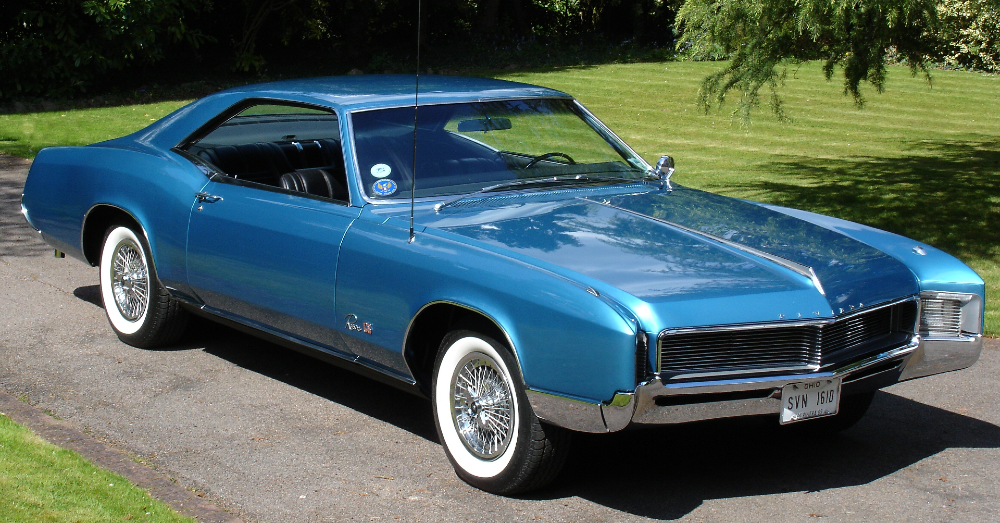The 1966 Buick Riviera ushered in the second generation of this iconic car. With this new model came a bold, timeless design we still admire today.
The 1966 Riviera featured a front bumper with a strong W-shape to it. This shape allowed the far edges of the front fascia to stick out much farther than the rest, providing what became a signature look. In addition to this strong front appearance, this Buick was long, bold, and fit perfectly into the muscle car era. Let’s see how this car continues to win over hearts and pique our imagination.
That front fascia tho
The W-shaped front of this classic Riviera continues to be a face we love to see today. The grille lines were long, expanding from edge to edge of the oddly shaped front. The headlights flipped up to be tucked away under the hood when not in use. This gave the classic Buick an incredible look with fewer interruptions. The sharp lines added a bit of aggression to the mix, and the generous use of chrome meant the Riviera made a statement as soon as it arrived. This new front-end shape was the signature feature of this 1966 Buick car.
A massive engine we can’t imagine today
The 1960s featured many large American muscle cars with big-block V8 engines. The 1966 Buick Riviera was one of them. This classic beauty featured a 7.0-liter V8 engine that pumped out 360 horsepower and 465 lb-ft of torque. As expected at the time, the engine used a set of Rochester 4-barrel carburetors to send the fuel mixture into the block to maximize power. The classic three-speed automatic transmission sent the power to the rear wheels to give this car impressive performance figures for the time.
When this Riviera was set up with the GS package, it was one of the most impressive muscle cars of the time. This big and heavy Buick could rocket to 60 mph in 7.5 seconds: a laughable time today but downright quick in the 1960s. This Riviera was also capable of completing a quarter-mile spring in 15.5 seconds at 88 mph while boasting a governed top speed of 124 mph.
This Riviera was supposed to be an FWD car
General Motors was pushing a new platform to its top three brands: Cadillac, Oldsmobile, and Buick. This new platform featured an FWD layout, but problems in the early testing prototypes meant the Riviera would stick with the RWD layout.
In addition to the troubles found in the FWD program, it cost more to create an FWD car than an RWD model, which also meant retooling factories. Staying with the RWD layout turned out to be a smart choice for Buick. The FWD Oldsmobile Toronado of the time showed durability problems in the FWD differential bearings.
The third reason the Buick team chose not to change the 1966 Riviera into an FWD car was the engineers didn’t like the way the big FWD car rode and handled. These cars tended to understeer, especially when pushed hard and fast. The Buick team was well aware that this car would be pushed hard; it is a 1960s muscle car and expected to perform as such out in public.
Where did the Buick get its style from?
Bill Mitchell was one of the top designers at Buick during the 1960s and provided a strong influence on what the 1966 Buick Riviera would become. Mitchell had a way of getting things done and offered incredible flair and style to the designs created. It’s Mitchell’s influence that created many of the red interiors found in GMC cars from the early 1960s and the shark-like style of the front end we see in the 1966 Riviera.
Unfortunately, this Buick muscle car was one of the final cars with a strong influence from Bill Mitchell. As the automotive world moved forward, regulations grew stronger, limiting the styling and design capabilities of many automakers. Things such as five-mile bumpers, smaller cars, and safety regulations boxed in this design genius to the point of stifling the style of future cars. Thankfully, the 1966 Riviera bore an impressive style that we still admire today.
A car we still love today
Although the Riviera lived on and was reborn for future models, the classic shapes with sharp lines on the front and rear coupled with curves and flowing panels for the rest of the body made the 1966 Buick Riviera special. You can see the influence of this car in models that came later, but none quite had the same boldness or singular design as the timeless classic that is the 1966 Buick Riviera.
This post may contain affiliate links. Meaning a commission is given should you decide to make a purchase through these links, at no cost to you. All products shown are researched and tested to give an accurate review for you.

